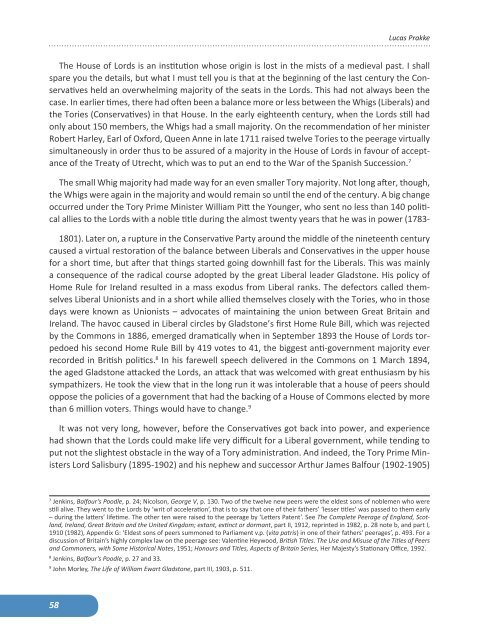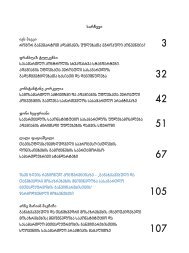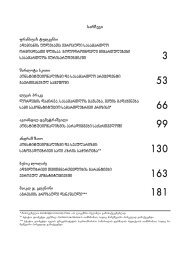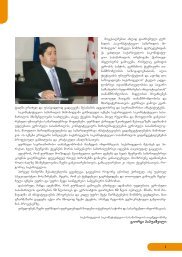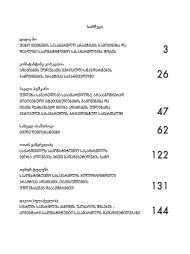Contents - Constitutional Court of Georgia
Contents - Constitutional Court of Georgia
Contents - Constitutional Court of Georgia
Create successful ePaper yourself
Turn your PDF publications into a flip-book with our unique Google optimized e-Paper software.
58<br />
Lucas Prakke<br />
The House <strong>of</strong> Lords is an institution whose origin is lost in the mists <strong>of</strong> a medieval past. I shall<br />
spare you the details, but what I must tell you is that at the beginning <strong>of</strong> the last century the Conservatives<br />
held an overwhelming majority <strong>of</strong> the seats in the Lords. This had not always been the<br />
case. In earlier times, there had <strong>of</strong>ten been a balance more or less between the Whigs (Liberals) and<br />
the Tories (Conservatives) in that House. In the early eighteenth century, when the Lords still had<br />
only about 150 members, the Whigs had a small majority. On the recommendation <strong>of</strong> her minister<br />
Robert Harley, Earl <strong>of</strong> Oxford, Queen Anne in late 1711 raised twelve Tories to the peerage virtually<br />
simultaneously in order thus to be assured <strong>of</strong> a majority in the House <strong>of</strong> Lords in favour <strong>of</strong> acceptance<br />
<strong>of</strong> the Treaty <strong>of</strong> Utrecht, which was to put an end to the War <strong>of</strong> the Spanish Succession. 7<br />
The small Whig majority had made way for an even smaller Tory majority. Not long after, though,<br />
the Whigs were again in the majority and would remain so until the end <strong>of</strong> the century. A big change<br />
occurred under the Tory Prime Minister William Pitt the Younger, who sent no less than 140 political<br />
allies to the Lords with a noble title during the almost twenty years that he was in power (1783-<br />
1801). Later on, a rupture in the Conservative Party around the middle <strong>of</strong> the nineteenth century<br />
caused a virtual restoration <strong>of</strong> the balance between Liberals and Conservatives in the upper house<br />
for a short time, but after that things started going downhill fast for the Liberals. This was mainly<br />
a consequence <strong>of</strong> the radical course adopted by the great Liberal leader Gladstone. His policy <strong>of</strong><br />
Home Rule for Ireland resulted in a mass exodus from Liberal ranks. The defectors called themselves<br />
Liberal Unionists and in a short while allied themselves closely with the Tories, who in those<br />
days were known as Unionists – advocates <strong>of</strong> maintaining the union between Great Britain and<br />
Ireland. The havoc caused in Liberal circles by Gladstone’s first Home Rule Bill, which was rejected<br />
by the Commons in 1886, emerged dramatically when in September 1893 the House <strong>of</strong> Lords torpedoed<br />
his second Home Rule Bill by 419 votes to 41, the biggest anti-government majority ever<br />
recorded in British politics. 8 In his farewell speech delivered in the Commons on 1 March 1894,<br />
the aged Gladstone attacked the Lords, an attack that was welcomed with great enthusiasm by his<br />
sympathizers. He took the view that in the long run it was intolerable that a house <strong>of</strong> peers should<br />
oppose the policies <strong>of</strong> a government that had the backing <strong>of</strong> a House <strong>of</strong> Commons elected by more<br />
than 6 million voters. Things would have to change. 9<br />
It was not very long, however, before the Conservatives got back into power, and experience<br />
had shown that the Lords could make life very difficult for a Liberal government, while tending to<br />
put not the slightest obstacle in the way <strong>of</strong> a Tory administration. And indeed, the Tory Prime Ministers<br />
Lord Salisbury (1895-1902) and his nephew and successor Arthur James Balfour (1902-1905)<br />
7 Jenkins, Balfour’s Poodle, p. 24; Nicolson, George V, p. 130. Two <strong>of</strong> the twelve new peers were the eldest sons <strong>of</strong> noblemen who were<br />
still alive. They went to the Lords by ‘writ <strong>of</strong> acceleration’, that is to say that one <strong>of</strong> their fathers’ ‘lesser titles’ was passed to them early<br />
– during the latters’ lifetime. The other ten were raised to the peerage by ‘Letters Patent’. See The Complete Peerage <strong>of</strong> England, Scotland,<br />
Ireland, Great Britain and the United Kingdom; extant, extinct or dormant, part II, 1912, reprinted in 1982, p. 28 note b, and part I,<br />
1910 (1982), Appendix G: ‘Eldest sons <strong>of</strong> peers summoned to Parliament v.p. (vita patris) in one <strong>of</strong> their fathers’ peerages’, p. 493. For a<br />
discussion <strong>of</strong> Britain’s highly complex law on the peerage see: Valentine Heywood, British Titles. The Use and Misuse <strong>of</strong> the Titles <strong>of</strong> Peers<br />
and Commoners, with Some Historical Notes, 1951; Honours and Titles, Aspects <strong>of</strong> Britain Series, Her Majesty’s Stationary Office, 1992.<br />
8 Jenkins, Balfour’s Poodle, p. 27 and 33.<br />
9 John Morley, The Life <strong>of</strong> William Ewart Gladstone, part III, 1903, p. 511.


